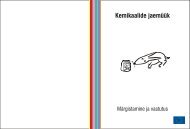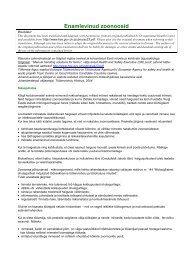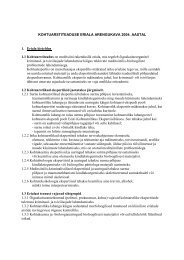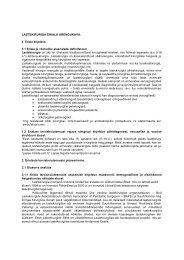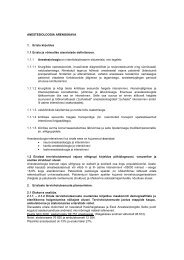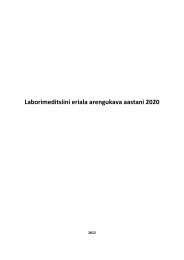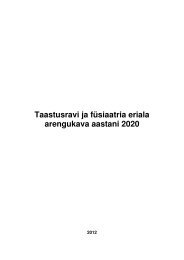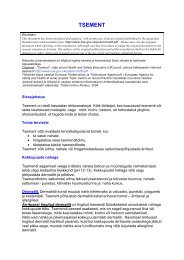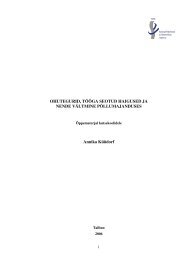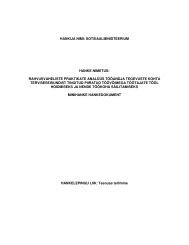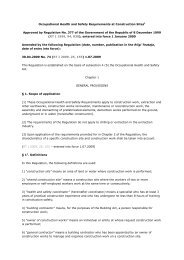- Page 1 and 2: IAEA HumAn HEAltH SErIES no. 4 Comp
- Page 3 and 4: COMPREHENSIVE CLINICAL AUDITS OF DI
- Page 5 and 6: IAEA HUMAN HEALTH SERIES No. 4 COMP
- Page 7 and 8: FOREWORD The application of radiati
- Page 9 and 10: CONTENTS 1. INTRODUCTION . . . . .
- Page 11 and 12: 5.1.3. Quality assurance processes
- Page 13 and 14: 1. INTRODUCTION 1.1. CLINICAL AUDIT
- Page 15 and 16: 1.1.3. Confidentiality of audits Co
- Page 17 and 18: evidence based medical research is
- Page 19 and 20: As a result of the comprehensive cl
- Page 21 and 22: The facility/institution is respons
- Page 23 and 24: 2.4.2. Review The review process wi
- Page 25 and 26: 2.5.1. Title page and contents page
- Page 27 and 28: 2.6. DISSEMINATION OF THE REPORT Th
- Page 29 and 30: A QA committee should be establishe
- Page 31 and 32: Lines of authority should be reflec
- Page 33 and 34: —Medical support equipment such a
- Page 35 and 36: (g) (h) (i) Make an assessment of t
- Page 37 and 38: (c) (d) (e) (f) Examine the facilit
- Page 39 and 40: (c) (d) Consider policy in regard t
- Page 41 and 42: equire a written policy and procedu
- Page 43: Once examination scheduling has bee
- Page 47 and 48: There should be a radiographer resp
- Page 49 and 50: —Recorded; —Systematically eval
- Page 51 and 52: 4.2.1.5. Pre-procedure screening an
- Page 53 and 54: (f) (g) (h) (i) (j) (k) (l) (m) (n)
- Page 55 and 56: 4.2.5. Report communication The aud
- Page 57 and 58: —Digital image receptors (compute
- Page 59 and 60: (b) (c) (d) Ensuring that appropria
- Page 61 and 62: 5.1.2.2. Occupational and public ex
- Page 63 and 64: (f) (g) Performance criteria for al
- Page 65 and 66: Dosimetry for those subjected to ra
- Page 67 and 68: 5.2.1.3. Management support The aud
- Page 69 and 70: (b) (c) Discuss the facility’s po
- Page 71 and 72: (g) (h) (i) Discuss with the medica
- Page 73 and 74: Professionals engaging in such prog
- Page 75 and 76: 6.2. THE AUDIT PROGRAMME 6.2.1. Edu
- Page 77: (d) (v) Regularity of research meet
- Page 80 and 81: Six months before audit Audited ins
- Page 82 and 83: Day 1: Morning: All audit team memb
- Page 84 and 85: Appendix III AUDIT REPORT FORMAT: S
- Page 86 and 87: Appendix IV AUDIT REPORT FORMS The
- Page 88 and 89: Audit criteria Adequacy Comments Su
- Page 90 and 91: Audit criteria Adequacy Comments Su
- Page 92 and 93: Audit criteria Adequacy Comments Su
- Page 94 and 95:
Audit criteria Adequacy Comments Su
- Page 96 and 97:
Audit criteria Adequacy Comments Su
- Page 98 and 99:
Audit criteria Adequacy Comments Su
- Page 100 and 101:
Audit criteria Adequacy Comments Su
- Page 102 and 103:
Audit criteria Adequacy Comments Su
- Page 104 and 105:
Audit criteria Adequacy Comments Su
- Page 106 and 107:
Audit criteria Adequacy Comments Su
- Page 108 and 109:
Audit criteria Adequacy Comments Su
- Page 110 and 111:
Audit criteria Adequacy Comments Su
- Page 112 and 113:
Audit criteria Adequacy Comments Su
- Page 114 and 115:
Audit criteria Adequacy Comments Su
- Page 116 and 117:
Audit criteria Adequacy Comments Su
- Page 118 and 119:
Audit criteria Adequacy Comments Su
- Page 120 and 121:
5.3. AUDIT REPORT FORMS FOR TECHNIC
- Page 122 and 123:
Audit criteria Adequacy Comments Su
- Page 124 and 125:
Audit criteria Adequacy Comments Su
- Page 126 and 127:
Audit criteria Adequacy Comments Su
- Page 128 and 129:
Audit criteria Adequacy Comments Su
- Page 130 and 131:
Audit criteria Adequacy Comments Su
- Page 132 and 133:
Audit criteria Adequacy Comments Su
- Page 134 and 135:
Audit criteria Adequacy Comments Su
- Page 136 and 137:
6.3. AUDIT REPORT FORMS FOR EDUCATI
- Page 138 and 139:
Audit criteria Adequacy Comments Su
- Page 140 and 141:
Audit criteria Adequacy Comments Su
- Page 142 and 143:
Audit criteria Adequacy Comments Su
- Page 144 and 145:
Appendix V NOTES ON PHYSICIST MEASU
- Page 146 and 147:
V.2.3. Other measurements The other
- Page 148 and 149:
[16] COMMISSION OF THE EUROPEAN COM
- Page 151 and 152:
Annex I APPLICATION FORM IAEA Clini
- Page 153 and 154:
Department Vision Statement and imm
- Page 155 and 156:
List of equipment Equipment type Id
- Page 157 and 158:
Annex II LIST OF ITEMS REQUESTED TO
- Page 159 and 160:
Annex III EQUIPMENT-SPECIFIC CHECKL
- Page 161 and 162:
Form RXR — Items to be reviewed b
- Page 163 and 164:
Form RXR — Items to be reviewed b
- Page 165 and 166:
Form FIF — Items to be reviewed b
- Page 167 and 168:
FORM FOR A MAMMOGRAPHY QA PROGRAMME
- Page 169 and 170:
Form MAM — Items to be reviewed b
- Page 171 and 172:
Form CTQ — Items to be reviewed b
- Page 173 and 174:
FORM FOR A SCREEN-FILM AND PROCESSO
- Page 175 and 176:
FORM FOR A COMPUTED OR DIGITAL RADI
- Page 177 and 178:
FORM FOR A VIEWING CONDITIONS (ANAL
- Page 179 and 180:
FORM FOR A QA PROGRAMME FOR HARD CO
- Page 181 and 182:
Form DPQ — Items to be reviewed b
- Page 183 and 184:
FORM FOR A QA PROGRAMME FOR ULTRASO
- Page 185 and 186:
FORM FOR A QA PROGRAMME FOR MRI For
- Page 187 and 188:
Form MRI — Items to be reviewed b
- Page 189 and 190:
TECHNIQUE OBSERVATION SHEET Radiogr
- Page 191 and 192:
Tube focus to tabletop distance d F
- Page 193 and 194:
K i Patient: Radiographic Calculati
- Page 195 and 196:
Manufacturer of phantom: __________
- Page 197 and 198:
P KA Patient: Fluoro 1 DETERMINATIO
- Page 199 and 200:
Phantom: MGD 1 CALCULATION OF INCID
- Page 201 and 202:
Phantom: CT1 MEASUREMENT OF C a,100
- Page 203 and 204:
REFERENCE TO ANNEX IV [IV-1] INTERN
- Page 205:
CONTRIBUTORS TO DRAFTING AND REVIEW
- Page 208 and 209:
Korea, Republic of KINS Inc., Infor



